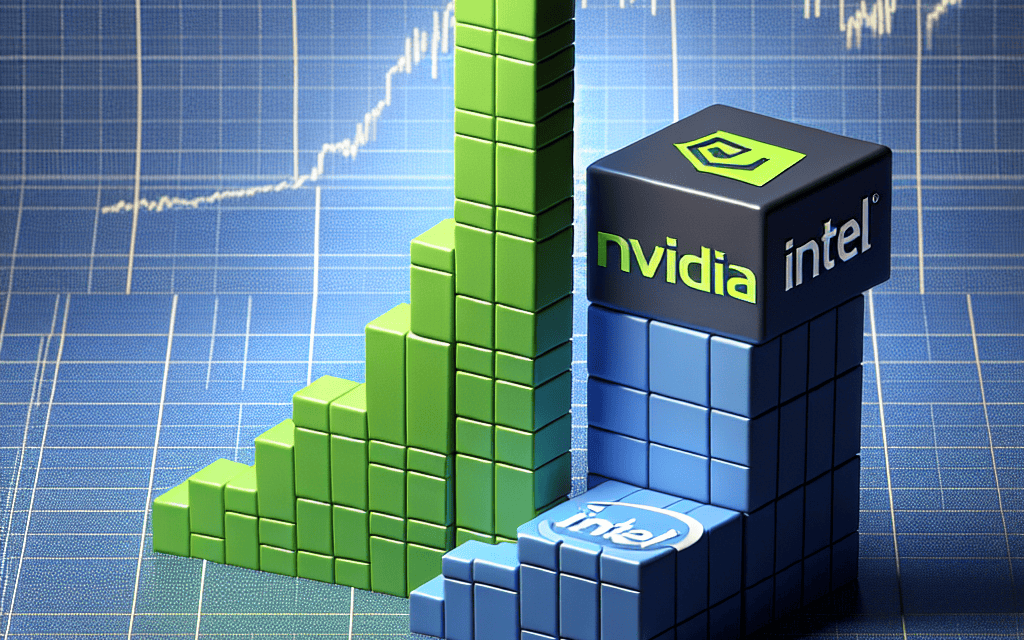“Nvidia: Powering Ahead, Redefining the Tech Landscape in the Dow Jones.”
Introduction
Nvidia, a leading player in the semiconductor industry, is on the brink of surpassing Intel in the Dow Jones Industrial Average, marking a significant shift in the technology sector’s landscape. This potential overtaking underscores Nvidia’s rapid growth and innovation, particularly in areas such as artificial intelligence, gaming, and data centers, which have driven its market valuation to unprecedented heights. Meanwhile, Intel, a long-standing giant in the chip manufacturing industry, faces challenges in maintaining its dominance amid evolving market demands and increased competition. The anticipated change in the Dow Jones Index reflects broader trends in the tech industry, highlighting Nvidia’s strategic advancements and the shifting dynamics of semiconductor leadership.
Nvidia’s Strategic Growth: Key Factors Behind Its Rise in the Dow Jones Index
Nvidia’s strategic growth in recent years has positioned it as a formidable contender in the technology sector, with the potential to overtake Intel in the Dow Jones Index. This shift is not merely a result of market fluctuations but rather a testament to Nvidia’s innovative strategies and forward-thinking approach. As we delve into the key factors behind Nvidia’s rise, it becomes evident that the company’s focus on diversification, technological advancement, and strategic partnerships has played a pivotal role in its ascent.
To begin with, Nvidia’s diversification strategy has been instrumental in its growth trajectory. While traditionally known for its graphics processing units (GPUs), Nvidia has expanded its portfolio to include a wide array of products and services. This includes advancements in artificial intelligence (AI), data centers, and autonomous vehicles. By broadening its scope, Nvidia has not only tapped into new revenue streams but also mitigated risks associated with reliance on a single product line. This diversification has allowed Nvidia to capture a larger market share and appeal to a broader customer base, thereby strengthening its position in the Dow Jones Index.
Moreover, Nvidia’s commitment to technological advancement has set it apart from its competitors. The company has consistently invested in research and development, leading to groundbreaking innovations that have reshaped the tech landscape. For instance, Nvidia’s AI-driven solutions have revolutionized industries ranging from healthcare to finance, enabling more efficient data processing and decision-making. Additionally, Nvidia’s GPUs have become the gold standard for high-performance computing, powering everything from gaming to scientific research. This relentless pursuit of innovation has not only enhanced Nvidia’s reputation but also driven its financial performance, contributing to its rise in the Dow Jones Index.
In addition to diversification and technological advancement, strategic partnerships have been a cornerstone of Nvidia’s growth strategy. By collaborating with industry leaders and forming alliances with key players, Nvidia has been able to leverage synergies and accelerate its market penetration. For example, partnerships with major cloud service providers have bolstered Nvidia’s presence in the data center market, while collaborations with automotive manufacturers have advanced its initiatives in autonomous driving technology. These strategic alliances have not only expanded Nvidia’s reach but also reinforced its competitive edge, further solidifying its standing in the Dow Jones Index.
Furthermore, Nvidia’s adeptness at navigating market trends and capitalizing on emerging opportunities has been a critical factor in its success. The company’s ability to anticipate and respond to shifts in consumer demand and technological advancements has enabled it to stay ahead of the curve. For instance, Nvidia’s early recognition of the potential of AI and machine learning positioned it as a leader in these fields, allowing it to capture significant market share as demand for AI solutions surged. This foresight and agility have been instrumental in driving Nvidia’s growth and enhancing its prominence in the Dow Jones Index.
In conclusion, Nvidia’s strategic growth can be attributed to a combination of diversification, technological innovation, strategic partnerships, and market acumen. These factors have collectively propelled Nvidia to the forefront of the technology sector, positioning it as a strong contender to overtake Intel in the Dow Jones Index. As Nvidia continues to build on its strengths and explore new opportunities, its trajectory serves as a compelling example of how strategic foresight and innovation can drive success in an ever-evolving market landscape.
Comparing Giants: How Nvidia’s Innovations Outpace Intel’s Traditional Stronghold
In the ever-evolving landscape of technology, the competition between industry giants often shapes the future of innovation and market dynamics. Nvidia and Intel, two titans in the semiconductor industry, have long been at the forefront of technological advancements. However, recent developments suggest that Nvidia is poised to overtake Intel in the Dow Jones Index, a shift that underscores the changing priorities and innovations within the sector. This potential transition is not merely a reflection of market capitalization but also an indication of how Nvidia’s strategic innovations are outpacing Intel’s traditional stronghold.
Nvidia, originally known for its graphics processing units (GPUs), has successfully expanded its reach into various high-growth areas such as artificial intelligence (AI), data centers, and autonomous vehicles. The company’s focus on AI has been particularly transformative, as its GPUs are now integral to machine learning and deep learning applications. This strategic pivot has allowed Nvidia to tap into burgeoning markets that are expected to drive future technological advancements. In contrast, Intel, historically dominant in the central processing unit (CPU) market, has faced challenges in adapting to these new technological demands. While Intel continues to hold a significant share in the CPU market, its attempts to diversify into areas like AI and data centers have not matched the pace or success of Nvidia’s endeavors.
Moreover, Nvidia’s innovative approach is evident in its development of the CUDA platform, which has become a cornerstone for parallel computing. This platform has enabled researchers and developers to harness the power of Nvidia’s GPUs for a wide range of applications beyond traditional graphics rendering. By fostering a robust ecosystem around its hardware, Nvidia has positioned itself as a leader in high-performance computing, further solidifying its competitive edge over Intel. On the other hand, Intel’s efforts to innovate within its existing product lines have been met with mixed results. The company has faced delays in advancing its manufacturing processes, which has hindered its ability to compete effectively in the rapidly evolving semiconductor market.
In addition to technological advancements, Nvidia’s strategic acquisitions have played a crucial role in its ascent. The acquisition of Mellanox Technologies, for instance, has strengthened Nvidia’s position in the data center market by enhancing its networking capabilities. Such strategic moves have allowed Nvidia to build a comprehensive portfolio that addresses the needs of modern computing environments. Conversely, Intel’s acquisition strategy has not yielded the same level of success, with some ventures failing to deliver the anticipated synergies or market impact.
Furthermore, the financial performance of both companies reflects these strategic differences. Nvidia’s revenue growth has been robust, driven by its success in capturing emerging markets and its ability to innovate rapidly. This financial strength has translated into increased investor confidence, contributing to its rising position in the Dow Jones Index. In contrast, Intel’s revenue growth has been more modest, constrained by its reliance on traditional markets and the challenges it faces in diversifying its product offerings.
In conclusion, the potential overtaking of Intel by Nvidia in the Dow Jones Index is emblematic of a broader shift within the technology sector. Nvidia’s ability to innovate and adapt to new market demands has positioned it as a formidable competitor, challenging Intel’s long-standing dominance. As the industry continues to evolve, the success of these companies will likely hinge on their capacity to anticipate and respond to the changing technological landscape. This dynamic underscores the importance of innovation and strategic foresight in maintaining a competitive edge in the ever-competitive semiconductor industry.
Market Dynamics: The Role of AI and Gaming in Nvidia’s Ascendancy Over Intel
Nvidia’s remarkable trajectory in the technology sector has positioned it on the brink of surpassing Intel in the Dow Jones Index, a development that underscores the shifting dynamics within the semiconductor industry. This potential overtaking is not merely a reflection of market capitalization but also an indication of broader trends that are reshaping the landscape of technology. Central to Nvidia’s ascendancy is its strategic focus on artificial intelligence (AI) and gaming, two sectors that have experienced exponential growth and are expected to continue their upward trajectory.
The rise of AI has been a game-changer for Nvidia, whose graphics processing units (GPUs) are particularly well-suited for the complex computations required by AI applications. Unlike traditional central processing units (CPUs), which are Intel’s forte, GPUs can handle multiple tasks simultaneously, making them ideal for machine learning and deep learning tasks. This capability has positioned Nvidia as a leader in the AI space, with its products being integral to the development of autonomous vehicles, data centers, and various AI-driven technologies. As industries increasingly adopt AI to enhance efficiency and innovation, Nvidia’s role as a key enabler of this technology has bolstered its market position.
In parallel, the gaming industry has been another significant driver of Nvidia’s growth. The demand for high-performance GPUs has surged as gaming has evolved from a niche hobby to a mainstream entertainment medium. Nvidia’s cutting-edge graphics cards have become essential for gamers seeking immersive experiences, driving robust sales and reinforcing the company’s dominance in this sector. Moreover, the rise of eSports and the growing popularity of virtual reality (VR) and augmented reality (AR) have further amplified the demand for Nvidia’s products, creating a virtuous cycle of innovation and consumer engagement.
While Nvidia has capitalized on these burgeoning markets, Intel has faced challenges in maintaining its historical dominance. The company has struggled with delays in advancing its manufacturing processes, which has hindered its ability to compete effectively in the rapidly evolving semiconductor landscape. Additionally, Intel’s focus on CPUs, while still significant, has not aligned as closely with the high-growth areas of AI and gaming as Nvidia’s GPU-centric strategy. Consequently, Intel has been compelled to rethink its approach, investing in new technologies and partnerships to regain its competitive edge.
The potential overtaking of Intel by Nvidia in the Dow Jones Index is emblematic of these broader industry shifts. It highlights the increasing importance of adaptability and innovation in a sector characterized by rapid technological advancements. As Nvidia continues to leverage its strengths in AI and gaming, it is well-positioned to capture emerging opportunities and expand its influence across various domains.
In conclusion, Nvidia’s poised ascendancy over Intel in the Dow Jones Index is a testament to the transformative impact of AI and gaming on the semiconductor industry. By aligning its strategic focus with these high-growth areas, Nvidia has not only enhanced its market position but also set a precedent for how technology companies can thrive in an era defined by digital transformation. As the industry continues to evolve, the interplay between AI, gaming, and semiconductor innovation will undoubtedly shape the future trajectory of market leaders like Nvidia and Intel.
Financial Performance: Analyzing Nvidia’s Earnings and Market Cap Surge

Nvidia Corporation, a leading player in the semiconductor industry, is on the brink of surpassing Intel Corporation in the Dow Jones Industrial Average, a development that underscores the shifting dynamics within the technology sector. This potential overtaking is not merely a reflection of market trends but also a testament to Nvidia’s robust financial performance and strategic positioning in the rapidly evolving tech landscape. As we delve into Nvidia’s recent earnings and market capitalization surge, it becomes evident that the company is strategically poised to redefine its standing among the giants of the industry.
In recent years, Nvidia has experienced a remarkable trajectory of growth, driven primarily by its innovative advancements in graphics processing units (GPUs) and its strategic expansion into artificial intelligence (AI) and data center markets. The company’s financial performance has been nothing short of impressive, with its latest earnings report showcasing a significant increase in revenue and profitability. This surge can be attributed to the growing demand for high-performance computing solutions, which Nvidia has adeptly capitalized on through its cutting-edge technologies.
Moreover, Nvidia’s market capitalization has seen a substantial rise, reflecting investor confidence in its long-term growth prospects. The company’s strategic acquisitions, such as the purchase of Mellanox Technologies and ARM Holdings, have further solidified its position in the semiconductor industry. These acquisitions have not only expanded Nvidia’s product portfolio but also enhanced its capabilities in AI and data center solutions, positioning it as a formidable competitor to traditional semiconductor giants like Intel.
Transitioning to the competitive landscape, Intel, once the undisputed leader in the semiconductor space, has faced challenges in recent years. The company has struggled with delays in its manufacturing processes and has been slow to adapt to the growing demand for AI and data center solutions. This has allowed Nvidia to gain a competitive edge, as it continues to innovate and deliver products that meet the evolving needs of the market. Consequently, Nvidia’s ability to outpace Intel in terms of market capitalization is indicative of a broader shift in the industry, where companies that prioritize innovation and adaptability are increasingly favored by investors.
Furthermore, Nvidia’s strategic focus on AI and machine learning has positioned it at the forefront of technological advancements. The company’s GPUs are widely recognized for their superior performance in AI applications, making them a preferred choice for researchers and developers worldwide. This has not only driven Nvidia’s revenue growth but also reinforced its reputation as a leader in the AI space. As AI continues to permeate various industries, Nvidia’s expertise in this domain is likely to serve as a catalyst for sustained growth.
In conclusion, Nvidia’s potential to overtake Intel in the Dow Jones Index is emblematic of its strategic foresight and ability to navigate the complexities of the semiconductor industry. The company’s impressive financial performance, coupled with its focus on innovation and strategic acquisitions, has positioned it as a formidable force in the tech sector. As Nvidia continues to capitalize on emerging opportunities in AI and data centers, it is well-equipped to maintain its upward trajectory and redefine its standing among the industry’s elite. This development not only highlights Nvidia’s success but also signals a broader transformation within the technology landscape, where agility and innovation are paramount to achieving sustained growth and market leadership.
Technological Advancements: Nvidia’s Edge in AI and Data Center Solutions
Nvidia Corporation, a leading player in the semiconductor industry, is on the brink of surpassing Intel Corporation in the Dow Jones Industrial Average, a development that underscores the shifting dynamics within the technology sector. This potential overtaking is not merely a reflection of market capitalization but also indicative of Nvidia’s strategic advancements in artificial intelligence (AI) and data center solutions, areas where it has demonstrated significant prowess. As the demand for AI-driven technologies and data processing capabilities continues to surge, Nvidia’s innovative approach and robust product offerings have positioned it favorably against traditional semiconductor giants like Intel.
The rise of Nvidia can be attributed to its early recognition of the transformative potential of AI and its subsequent investments in developing cutting-edge graphics processing units (GPUs) that cater to this burgeoning field. Unlike central processing units (CPUs), which are Intel’s forte, GPUs are designed to handle multiple tasks simultaneously, making them ideal for AI applications that require vast computational power. This strategic focus has allowed Nvidia to capture a substantial share of the AI market, as industries ranging from healthcare to automotive increasingly rely on AI for data analysis, machine learning, and automation.
Moreover, Nvidia’s foray into data center solutions has further solidified its position as a formidable competitor to Intel. The company’s data center business has experienced exponential growth, driven by the increasing need for efficient data processing and storage solutions. Nvidia’s GPUs are now integral components in data centers worldwide, providing the necessary infrastructure to support cloud computing, big data analytics, and other data-intensive applications. This expansion into data centers has not only diversified Nvidia’s revenue streams but also enhanced its reputation as a leader in high-performance computing.
In contrast, Intel has faced challenges in adapting to the rapidly evolving technological landscape. While it remains a dominant force in the CPU market, Intel has struggled to keep pace with the innovations spearheaded by Nvidia in AI and data center technologies. The delay in transitioning to more advanced manufacturing processes has further hindered Intel’s ability to compete effectively. Consequently, Intel’s market share in these critical areas has been eroded, allowing Nvidia to gain a competitive edge.
Furthermore, Nvidia’s strategic acquisitions have bolstered its capabilities and market position. The acquisition of Mellanox Technologies, a leader in high-performance interconnect technology, has enhanced Nvidia’s data center offerings, enabling it to deliver comprehensive solutions that address the growing demands of modern computing environments. This acquisition strategy has not only expanded Nvidia’s technological portfolio but also strengthened its foothold in key markets.
As Nvidia continues to innovate and expand its influence in AI and data center solutions, its potential to overtake Intel in the Dow Jones Industrial Average becomes increasingly plausible. This shift reflects a broader trend within the technology sector, where companies that prioritize innovation and adaptability are poised to thrive. While Intel remains a significant player, the momentum is clearly with Nvidia, whose strategic focus on AI and data center technologies aligns with the future trajectory of the industry.
In conclusion, Nvidia’s ascent in the Dow Jones Industrial Average is emblematic of its success in capitalizing on the growing demand for AI and data center solutions. Through strategic investments, innovative product development, and strategic acquisitions, Nvidia has positioned itself as a leader in these critical areas, challenging the traditional dominance of Intel. As the technology landscape continues to evolve, Nvidia’s ability to adapt and innovate will likely ensure its continued prominence in the industry.
Investment Trends: Why Investors Are Favoring Nvidia Over Intel
In recent years, the investment landscape has witnessed a significant shift, with Nvidia emerging as a formidable contender poised to overtake Intel in the Dow Jones Index. This transition is not merely a reflection of changing market dynamics but also indicative of broader trends within the technology sector. As investors increasingly favor Nvidia over Intel, several factors contribute to this evolving preference, underscoring the strategic decisions and market conditions that have propelled Nvidia to the forefront.
To begin with, Nvidia’s robust growth trajectory has been fueled by its strategic focus on high-performance computing and artificial intelligence (AI). The company’s innovative approach to graphics processing units (GPUs) has positioned it as a leader in AI and machine learning applications, areas that are experiencing exponential growth. This focus on cutting-edge technology has not only expanded Nvidia’s market share but also enhanced its appeal to investors seeking exposure to future-oriented sectors. In contrast, Intel, traditionally dominant in the central processing unit (CPU) market, has faced challenges in adapting to these rapidly evolving technological demands.
Moreover, Nvidia’s financial performance has been a key driver of investor confidence. The company has consistently reported strong revenue growth, driven by its diversified product portfolio and strategic acquisitions. For instance, Nvidia’s acquisition of Mellanox Technologies in 2020 bolstered its data center capabilities, further solidifying its position in the market. This financial resilience, coupled with a forward-looking strategy, has made Nvidia an attractive option for investors seeking stability and growth potential. On the other hand, Intel has encountered hurdles, including delays in product launches and increased competition, which have impacted its financial performance and investor sentiment.
In addition to financial metrics, Nvidia’s commitment to sustainability and corporate responsibility has resonated with a growing segment of socially conscious investors. The company has made significant strides in reducing its carbon footprint and promoting ethical business practices, aligning with the values of environmentally and socially responsible investment strategies. This alignment has not only enhanced Nvidia’s brand reputation but also attracted investors who prioritize environmental, social, and governance (ESG) criteria in their investment decisions. Conversely, Intel has faced scrutiny over its environmental impact and corporate governance practices, which may have influenced investor perceptions.
Furthermore, the broader market trends have also played a role in shaping investor preferences. The increasing demand for AI, cloud computing, and autonomous vehicles has created a favorable environment for companies like Nvidia that are at the forefront of these innovations. As industries across the board integrate AI and machine learning into their operations, Nvidia’s products and solutions have become indispensable, further driving its growth prospects. In contrast, Intel’s traditional focus on CPUs has limited its exposure to these high-growth areas, potentially diminishing its attractiveness to investors seeking to capitalize on emerging trends.
In conclusion, the shift in investor preference from Intel to Nvidia within the Dow Jones Index is a multifaceted phenomenon driven by Nvidia’s strategic focus on innovation, strong financial performance, commitment to sustainability, and alignment with broader market trends. As Nvidia continues to capitalize on its strengths and adapt to the evolving technological landscape, it is well-positioned to maintain its upward trajectory, potentially surpassing Intel in the index. This transition not only highlights the dynamic nature of the technology sector but also underscores the importance of strategic foresight and adaptability in navigating the ever-changing investment landscape.
Future Outlook: What Nvidia’s Potential Overtaking of Intel Means for the Tech Industry
Nvidia’s potential to overtake Intel in the Dow Jones Index marks a significant shift in the tech industry, reflecting broader trends in technology and market dynamics. As Nvidia continues to expand its influence, the implications for the tech sector are profound, signaling a transformation in how companies are valued and what technologies are prioritized. This potential overtaking is not merely a matter of market capitalization; it represents a deeper narrative about the evolving landscape of technology and innovation.
To understand the significance of Nvidia’s rise, it is essential to consider the company’s strategic focus on artificial intelligence (AI) and graphics processing units (GPUs). Nvidia has positioned itself at the forefront of AI development, with its GPUs becoming the backbone of AI research and applications. This focus has allowed Nvidia to tap into a rapidly growing market, as AI technologies are increasingly integrated into various industries, from healthcare to automotive. In contrast, Intel, traditionally known for its dominance in central processing units (CPUs), has faced challenges in adapting to these new technological demands. While Intel remains a formidable player, its slower transition to AI and GPU technologies has impacted its market position.
Moreover, Nvidia’s potential overtaking of Intel highlights the shifting priorities within the tech industry. As companies and consumers alike demand more powerful and efficient computing solutions, the emphasis has moved from traditional CPUs to GPUs and AI-driven technologies. This shift is not only about performance but also about energy efficiency and scalability, areas where Nvidia has excelled. The company’s innovations in parallel processing and machine learning have set new standards, pushing the boundaries of what is possible in computing.
Furthermore, Nvidia’s strategic acquisitions and partnerships have bolstered its position in the market. The acquisition of Mellanox Technologies, for instance, has enhanced Nvidia’s capabilities in data center solutions, a critical area as cloud computing continues to expand. These strategic moves have allowed Nvidia to diversify its offerings and strengthen its foothold in key markets, providing a competitive edge over Intel.
In addition to technological advancements, Nvidia’s potential rise in the Dow Jones Index reflects broader economic and market trends. Investors are increasingly looking for companies that demonstrate not only strong financial performance but also a clear vision for the future. Nvidia’s commitment to innovation and its ability to anticipate market needs have made it an attractive option for investors seeking growth opportunities in the tech sector. This investor confidence is a testament to Nvidia’s strategic foresight and its ability to execute on its vision.
As Nvidia stands on the brink of overtaking Intel, the implications for the tech industry are far-reaching. This potential shift underscores the importance of adaptability and innovation in a rapidly changing market. Companies that can anticipate and respond to technological trends are more likely to succeed, while those that remain static risk being left behind. For the tech industry as a whole, Nvidia’s rise serves as a reminder of the dynamic nature of technology and the need for continuous evolution.
In conclusion, Nvidia’s potential overtaking of Intel in the Dow Jones Index is more than a financial milestone; it is a reflection of the changing tides in technology and market dynamics. As Nvidia continues to lead in AI and GPU technologies, the tech industry must adapt to these new realities, embracing innovation and strategic foresight to thrive in an increasingly competitive landscape.
Q&A
1. **What is the Dow Jones Index?**
The Dow Jones Industrial Average (DJIA) is a stock market index that measures the stock performance of 30 large companies listed on stock exchanges in the United States.
2. **Why is Nvidia poised to overtake Intel in the Dow Jones Index?**
Nvidia’s strong financial performance, driven by its leadership in graphics processing units (GPUs) and advancements in AI and data center technologies, has led to a significant increase in its market capitalization, potentially surpassing Intel.
3. **What factors contribute to Nvidia’s growth?**
Nvidia’s growth is fueled by its dominance in the gaming industry, expansion into AI and machine learning, strategic partnerships, and innovations in data center and automotive technologies.
4. **How does Intel’s performance compare to Nvidia’s?**
Intel has faced challenges such as delays in manufacturing advancements and increased competition, which have impacted its growth compared to Nvidia’s rapid expansion and innovation.
5. **What impact does Nvidia’s potential overtaking of Intel have on the tech industry?**
Nvidia surpassing Intel could signify a shift in the semiconductor industry, highlighting the growing importance of GPUs and AI technologies over traditional CPU dominance.
6. **What are the implications for investors if Nvidia overtakes Intel?**
Investors might see Nvidia as a more attractive investment due to its growth potential and leadership in emerging technologies, possibly leading to increased stock demand and valuation.
7. **How might Intel respond to Nvidia’s rise?**
Intel may focus on accelerating its technological advancements, diversifying its product offerings, and strengthening its position in key markets to regain competitive advantage.
Conclusion
Nvidia’s potential to overtake Intel in the Dow Jones Index is indicative of its rapid growth and increasing influence in the technology sector. This shift reflects Nvidia’s strategic advancements in areas such as artificial intelligence, data centers, and gaming, which have driven significant revenue growth and market capitalization. Meanwhile, Intel has faced challenges in maintaining its competitive edge, particularly in the semiconductor industry. Nvidia’s innovative approach and successful market penetration position it as a formidable player, potentially surpassing Intel in the Dow Jones Index and signaling a broader transformation within the tech industry landscape.





